Poirot: Series 4 Blu-ray Movie
HomePoirot: Series 4 Blu-ray Movie 
Acorn Media | 1992 | 306 min | Not rated | Apr 24, 2012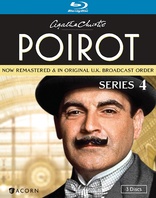
Movie rating
8.3 | / 10 |
Blu-ray rating
| Users | 0.0 | |
| Reviewer | 4.5 | |
| Overall | 4.5 |
Overview
Poirot: Series 4 (1992)
For the fourth season of mysteries to be solved by Agatha Christie's brilliant Belgian detective, the ITV series focused entirely on feature-length adaptations of Christie's novels. Included are "The ABC Murders", "Death in the Clouds" and "One, Two, Buckle My Shoe".
Starring: David Suchet, Hugh Fraser (I), Philip Jackson (II), Pauline Moran, David YellandDirector: Edward Bennett (I), Andrew Grieve, Renny Rye, Brian Farnham
| Period | Uncertain |
| Mystery | Uncertain |
| Crime | Uncertain |
| Drama | Uncertain |
| Thriller | Uncertain |
Specifications
Video
Video codec: MPEG-4 AVC
Video resolution: 1080p
Aspect ratio: 1.33:1
Original aspect ratio: 1.78:1, 1.33:1
Audio
English: LPCM 2.0
Subtitles
English SDH
Discs
25GB Blu-ray Disc
Three-disc set (3 BDs)
Packaging
Slipcover in original pressing
Playback
Region A (locked)
Review
Rating summary
| Movie | 5.0 | |
| Video | 4.5 | |
| Audio | 3.5 | |
| Extras | 0.0 | |
| Overall | 4.5 |
Poirot: Series 4 Blu-ray Movie Review
The Little Gray Cells Play the Long Game
Reviewed by Michael Reuben April 16, 2012With their successful dramatization of Agatha Christie's first novel, The Mysterious Affair at Styles, which aired between Series 2 and 3 of Poirot, the show's producers were now fully prepared to tackle the longer form. Series 4, which was broadcast in January 1992, consisted of three feature-length mysteries based on mostly faithful adaptations of novels featuring Christie's infallible Belgian detective, Hercule Poirot, played, as he still is today, by the incomparable David Suchet. To the disappointment of many of the show's fans, Poirot's devotedly practical secretary, Miss Lemon, did not appear in any of these movies, and his loyal partner, Captain Hastings (Hugh Fraser), appeared in only the first. Indeed, Poirot is most often seen alone in his comfortable lodgings at Whitehaven Mansions, which double as his office. But Scotland Yard's dogged Chief Inspector Japp (Philip Jackson) remained a familiar and reassuring presence in all three. (In later years, as in the novels, Japp too would disappear from Poirot's cases.) The dark tone that intruded into Series 3 reappears with new intensity in the final mystery of this series in various ways that will be familiar to those already know the story. Among them is the fact that a murder victim is someone whom Poirot himself has known for a long time (though strictly on a professional basis). Another, which is not obvious from the story itself, is that the original novel of One, Two, Buckle My Shoe was written in 1940 during a period of the Second World War when Britain's prospects were not favorable. The pessimism of the era strongly influenced the story, as did some of its political themes. These remain evident in the screen adaptation.
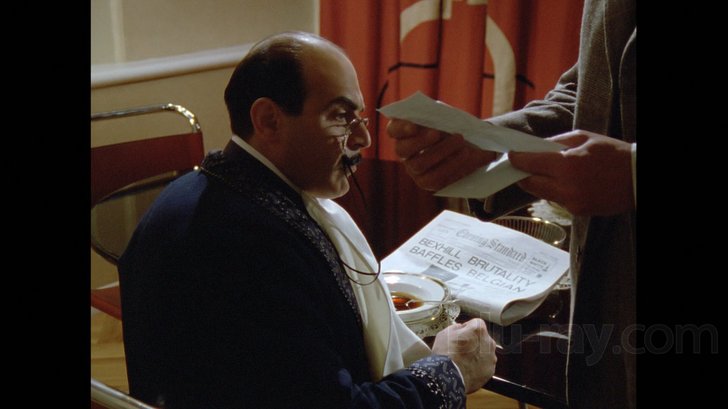
Harsh headlines
The ABC Murders In Christie's variation (and foreshadowing) of the Zodiac killer, Poirot receives a series of letters inviting him to "play". Each letters provides a date when a murder will take place and the town where it will occur, and is signed "ABC". The first town is Andover; the second is Bexhill; the third is Churston. Victims are found in each city, without apparent connection to each other, no matter how deeply Poirot and Hastings dig into each one's past and present. As a further taunt, the killer plants an opened copy of the "ABC" railway guide at each crime scene. Is it a clue or just more misdirection? As the geography of the case expands, Poirot finds himself dealing with numerous police officials besides his usual comrade-in-arms, Chief Inspector Japp. Not all of them are as respectful of his gifts. The newspapers also prove fickle, as headlines blare Poirot's failure to stop the ABC killer. After the third victim is found, an informal association is formed by the relatives of all three, and one of the more interesting scenes in the film occurs midway through when Poirot gathers this group in his office to search for some missing element that might supply a link among the victims. It's the kind of scene that usually appears at the end of a Poirot story; seeing such a gathering when the investigation is nowhere near its conclusion casts it in a whole new light. Quite early on, the audience (but not Poirot or the authorities) is introduced to one Alexander Cust, a traveling salesman whose withdrawn demeanor and quietly eccentric manner certainly give him the "look" of a serial killer. As the action cuts back and forth between Poirot and Cust, the latter appears to be closing in a fourth victim in the town of Doncaster, while Poirot eventually begins closing in on Cust. At Cust's apprehension, substantial evidence incriminates him, but Poirot remains troubled by loose ends. Now the real detective work begins. Wonderful comic relief is provided at the expense of Hastings, who has just returned from a six-month trip to South America, where he bagged a caiman (a variety of alligator), which he had stuffed as a gift for his old friend and partner. The reptile's hideous visage and offensive odor are a running joke throughout the film, as are Hastings' repeated attempts to tell the story of the hunt, which never get past the first sentence without someone interrupting the poor fellow. Death in the Clouds A murder on an airplane? In the seat directly across the aisle from Hercule Poirot? Pride alone demands that the great detective solve the case. He was asleep when the crime occurred, a state much desired by the dapper Belgian during air travel, which, as we know from "Peril at End House", he finds most unnerving. During a holiday in Paris, Poirot can't help but notice Lord and Lady Horbury (David Firth and Cathryn Harrison), who have come with their friend Venetia Kerr (Amanda Royle) to watch the national tennis finals. Tensions are running high between the Horburys, because Lady Horbury is a compulsive gambler, whose nightly visits to the casino have run up huge debts with a loan shark, Madame Giselle (Eve Pearce), who has become quite public in her demands for payment. Indeed, Madame Giselle even boards the same plane back to London as Lady Horbury, along with Poirot and an assortment of other personalities, including the stewardess (as they were still called then), Jane Grey (Sarah Woodward), whom Poirot has befriended during his stay. Alas, Madame Giselle never has another chance to collect her debt. By the time the plane arrives in England, she is dead from a poison dart to the neck. Another of Agatha Christie's detectives, Miss Marple, observed that the obvious person is usually the murderer. In her best Poirot stories, Christie presented the great detective with a plethora of obvious persons, thereby increasing the challenge for both Poirot and the reader (or, here, the viewer). Lady Horbury is obvious, but so is her husband, who has conspicuously returned to London the day before, as if to establish an alibi while a confederate carries out the murder. Poirot's new friend, Jane Grey, and her co-worker, a steward named Mitchell (John Bleasdale), were among the few people to pass near Madam Giselle during the flight. An archaeologist (Jean Dupont) was traveling with a case full of antiquities that included blowpipes. And a famous mystery novelist, Daniel Clancy (Roger Heathcott), turns out to have extensive knowledge of blowpipes and poison-tipped darts due to research he claims he once did for a book (that he never wrote!). Clancy was also a third person who's known to have passed near the victim's sear during the flight. Further complications arise when a mystery person suddenly appears claiming entitlement to Madame Giselle's considerable fortune. The person proves just as elusive as the truth about the murder. Everything leads to one of those great Christie resolutions, where Poirot gathers all the interested parties together in one room, then proceeds to explain the crime and ID the perpetrator(s). These always work best in the long form, where sufficient time has been allowed to explore the possibilities and set up the multiple alternatives. This one is particularly well done. Although Hastings does not appear, Death in the Clouds doesn't lack for comedy, much of it courtesy of an open rivalry between Chief Inspector Japp of Scotland Yard and Inspector Fournier (Richard Ireson) of the French Sureté. Japp's presumption in favor of all things English is classic. One, Two, Buckle My Shoe In an unusual turn for an episode of Poirot, the audience knows more than the master sleuth. We're shown a murder (though not the murderer) during opening credits; then we're treated to a flashback supplying crucial information about motive that Poirot himself will not uncover until much later in the story. Newsreel footage reports on a state visit to India in 1925 by the Prince of Wales (the future King Edward who will abdicate his throne to marry the divorced American, Mrs. Simpson). A troop of actors is performing Shakespeare's Much Ado About Nothing for the many English ex-patriots living or stationed in what the Victorians used to call "the jewel in the crown" of the British Empire. The actress playing Beatrice is named Gerda (Joanna Phillips-Lane). Her best friend, who has only a small part, is Mabelle Sainsbury-Seale (Carolyn Colquhoun). A dashing young banker, Martin Alistair Blunt (Peter Blythe), who has come to India on holiday, is smitten with Gerda, and they try to get a glimpse of the visiting Prince but are unsuccessful. Then they tell Mabelle they're engaged. London, twelve years later. Poirot has an appointment with his dentist, Henry Morley (Laurence Harrington). It turns out that another of Morley's patients is Martin Alistair Blunt, long since returned to England and now the wealthiest and most successful banker in London, certainly in England and perhaps all of Europe. Shortly, Morley will acquire some new patients. One of them is Mabel Sainsbury-Seale, just now returned from India, after abandoning acting and devoting herself to charity work. Without knowing who she is, Poirot encounters her exiting a cab as he leaves a follow-up appointment. A second new patient is Mr. Amberiotis (Kevork Malikyan), a Greek traveler whom Mabelle met on shipboard and is staying at the same hotel; she gave him Morley's name, when she saw he was suffering from toothache. Hours after Poirot's last appointment, Morley is found dead on the floor of his consulting room of a gunshot wound to the head, apparently self-inflicted. The reason for his distress appears to be explained when Mr. Amberiotis dies soon thereafter of an overdose of dental anesthesia. The police theory is that Morley realized his mistake and shot himself in an excess of guilt. Poirot doesn't buy any of this, especially when, after he and Chief Inspector Japp have interviewed Mabelle Sainsbury-Seale, she suddenly disappears. Further complications arise through Morley's assistant, Gladys Neville (Karen Gledhill). She recently became engaged to a young man, Frank Carter (Christopher Eccleston, before he became famous as the first new Dr. Who). Morley considered Carter unsuitable and advised Gladys against him. Among other things, Carter is a member of the British fascist party and, having recently lost his regular job, has suddenly been hired at a good salary by some mysterious "government" entity he won't disclose. He also may have arranged for Gladys to be conveniently away from Morley's office on the day of his death. I have omitted salient details, including a big reveal that the audience learns well in advance of Poirot. As with an episode of Columbo, the question that keeps our interest is how the wily investigator will find his way to what we, from our privileged seat, have already been shown. And like Lt. Columbo, whose creators clearly studied their Agatha Christie, Poirot solves the case through strict attention to detail. The title of the story was not chosen at random.
Poirot: Series 4 Blu-ray Movie, Video Quality 
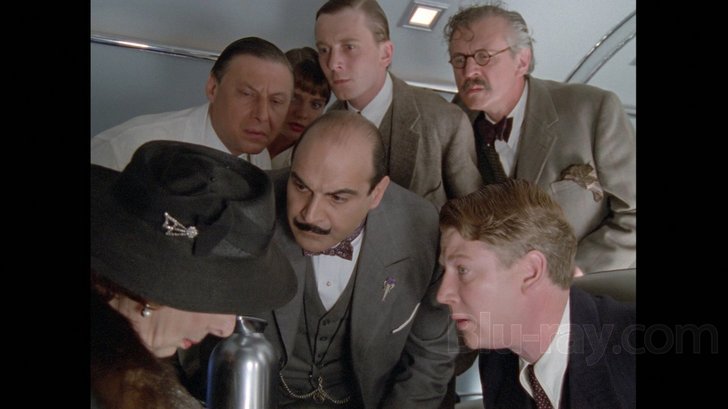
As with the previous three series, Series 4 of Poirot was shot on 16mm film, but, if anything, the image on Acorn Media's 1080p, AVC-encoded Blu-ray is an improvement over previous seasons, perhaps because of better film stocks or superior lenses. So sharp is the image that, in some shots, one would almost swear that the production had switched to 35mm. Detail, black levels and color differentiation are excellent, and there are fewer shots than in previous seasons where graininess becomes a problem. The exception is the India flashback sequence at the beginning of One, Two, Buckle My Shoe, where the graininess is obviously a deliberate effect of overexposure, because it is consistent throughout the sequence and ends as soon as we jump forward twelve years to the story's "present day". The additional texture both creates a sense of an earlier time and helps with the makeup necessary to change the actors into their younger selves. Compression artifacts were nowhere to be seen, and there were no signs of inappropriate digital manipulation. Acorn Media continues to set high standards with their Blu-ray editions of Poirot.
Poirot: Series 4 Blu-ray Movie, Audio Quality 
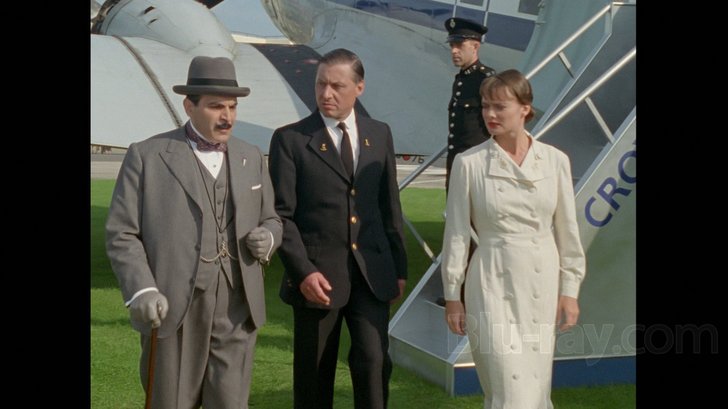
As with Series 3, Acorn Media has provided lossless encoding of Poirot's mono soundtrack in the form of PCM 2.0. Lossless purists can rest assured that they are getting the full dynamic range of every syllable, sound effect and note of Christopher Gunning's consistently fine score. Again, as with prior series, the identical left and right channels collapse to the center when played through a matrix decoder. As long as your system features a capable center channel speaker and a sub for the low notes, the audio experience provided by these Blu-ray discs should be a pleasure.
Poirot: Series 4 Blu-ray Movie, Special Features and Extras 
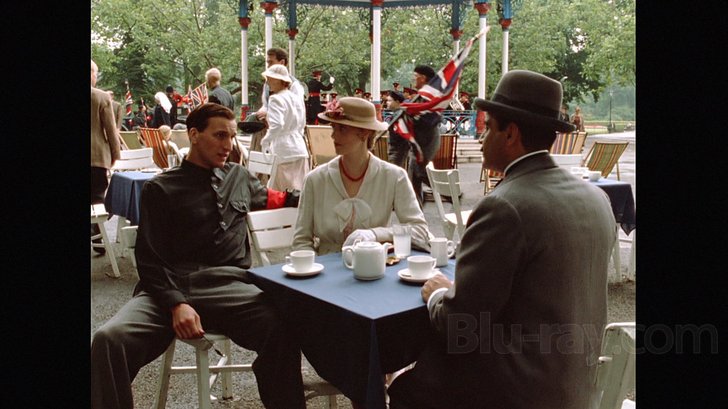
Other than introductory trailers on disc 1 for Acorn Media, Single-Handed and Vera, no extras are included.
Poirot: Series 4 Blu-ray Movie, Overall Score and Recommendation 
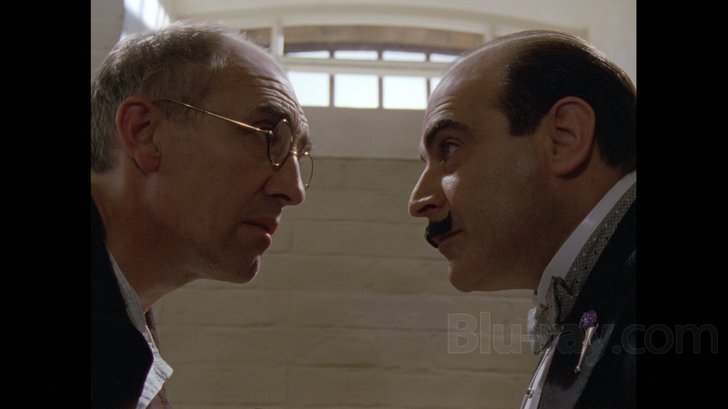
As filming continues on the thirteenth and final series of Poirot, Acorn Media seems to be in a hurry to bring the entire show to Blu-ray, and they are doing a superlative job. Series 5 has already been announced for July, and it's my understanding that at least one more series will be released in 2012. Expect the balance to be released in 2013, just in time for the grand debut of the final season. This is some of the finest TV not available on an American cable channel. Highly recommended.
Other editions
Poirot: Other Seasons

Poirot: Series 1
1989

Poirot: Series 2
1990

Poirot: Series 3
1991

Poirot: Series 5
1993

Poirot: Series 6
1995-1996

Poirot: Series 7 & 8
2000-2001

Poirot: Series 9
2003-2004

Agatha Christie's Death on the Nile
2004

Poirot: Series 10
2006

Poirot: Series 11
2008-2009

Poirot: The Movie Collection - Set 6
2009-2010

Poirot: Murder on the Orient Express
2010

Poirot: Series 12
2010-2011

Poirot: Series 13
2013
Similar titles
Similar titles you might also like
(Still not reliable for this title)

The Mirror Crack'd
1980

State of Play
2009

Murdoch Mysteries: Season 18
The Artful Detective
2024-2025

Zodiac 4K
Theatrical 4K | Director's Cut BD only
2007

Foyle's War: Set 8
2014

The Night of the Generals
Limited Edition to 3000 - SOLD OUT
1967

Murder on the Orient Express 4K
50th Anniversary Edition
1974

Miss Marple: Volume 1
The Murder at the Vicarage / The Body in the Library / The Moving Finger / A Murder is Announced
1984-1986

The Raven
2012

Murder on the Orient Express
2017

Twisted
2004

The Black Dahlia
2006

Evil Under the Sun
1982

Gosford Park
Arrow Academy
2001

Crooked House
2017

The Girl with the Dragon Tattoo
2011

The Bone Collector 4K
1999

Murder by Decree 4K
1979

Taboo: Season One
2017

L.A. Confidential
1997